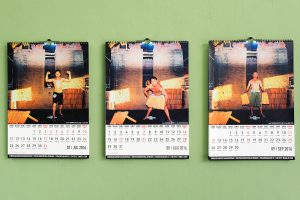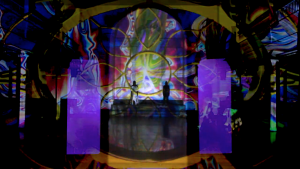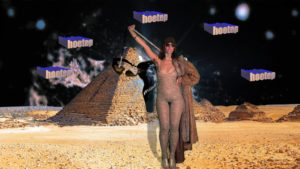Where do we put our faith? In the fight for the future, certain things normally drop out, which isn’t an option for South African collective NTU (members Nolan Dennis, Bogosi Sekhukhuni and Tabita Rezaire). Keenly aware of the need to reconsider allegiances to separatist western narratives of progress, wherein only certain ideas get heard and coded into a future vision, their ongoing project, NTUSAVE is a mission to recover lost technologies. Broadly defined as both the ways of doing something, and the means of organisation, refering to both artefacts and methodologies, technologies aren’t neutral. “I believe strongly that traditions of African spirituality and her abundant, complex systems of knowledge have so much more to offer us than pride or self worth,” notes NTU member Sekhukhuni in a conversation carried out over Google Docs, talking about the process of rediscovery as an urgent step in self- preservation and welfare, with the “potential to holistically assist our daily lives in ways western intellectual thinking cannot.”

Between April 29 to June 11, the trio presented NTU: Ubulawu, their first UK exhibition, which ran at London’s Auto Italia. On entering the unassuming Bethnal Green space on a sleepy Sunday, I’m met by the sounds of cascading water. The air is wet. It feels generative. By the time I get around to reading the press release, I am already transported. The group initially came together through shared interests in esoteric African history, spiritual traditions and cultures of technology, but behind NTU lies the fact that these proclaimed ‘digital-healers’ are survivalists too. For Sekhukhuni, the “desire to change the perceptions and visual language of what advanced technology can look like” is central. While we’re now arguably used (read, familiar and addicted) to the trans-meditative state supported by technologies such as the Internet, we shouldn’t be such sticklers. There are other things that can get us there. And, as it turns out, nature has its own ideas. Don’t let her humble aesthetics fool you, the saviour comes in unexpected hardware. Plant clippings and H2O might just be our most crucial resources in the fight for the future.
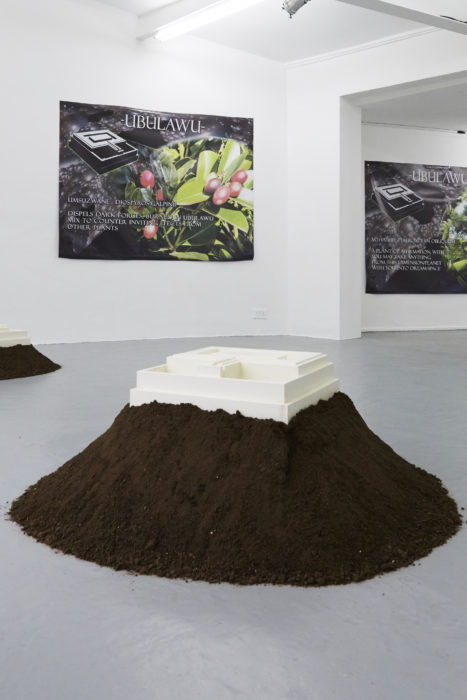
Symbiosis is a major key here. CAD (computer-aided-design), InDesign and natural formation coalesce. Two screens, happily submerged in a pool of water, installed in a vitrine, fill the back room. White box structures resembling ancient temples or libation tables (a dedicated space to make liquid offerings to gods) are nestled into neat mounds of earth — like little ant hills scattered across the project space. In the tops of each of these structures, which look like crop circles, are different plant clippings, identified by corresponding graphic posters on the wall behind each mound. I learn about Umthunyelelwa – Leurostylia Capensis, Umsuzwane – Diospyros Galpinii, and Mthathe – Ptaeroxolyn Obliquum. Amidst these structures (based on designs from Kemetic tradition; a spiritual sect based on Ancient Egyptian religion) and the ‘video lagoon,’ NTU introduce us to their not-so-new materials: water, and the recommended accompaniment, Ubulawu, a psychoactive medicinal root, commonly known and used in South African tribes, like the Xhosa and Zulu, that induces a lucid-dream state. The hardware; the devices themselves, might not be what you’d expect but it’s the content that counts. NTU educate us on these natural technologies — invoking the psychotropic, the phytochemical and the ethnobotanic along the way.
We know water is vital to survival. We’re made up of 70 per cent of it. We know we must hydrate. That much is common knowledge. But I bet you didn’t know that water is conscious. According to NTU, water has been a free radical all along. And it isn’t only conscious material, it’s resistant technology.

Over the course of their research, (which Nolan explains over Google Doc combines “libation apparatuses, water therapy, cryptographic interfaces, alternative currencies, ancient knowledge, non-human intelligence, and hidden global networks”), the trio came across the laboratory experiments of Dr Masaru Emoto and Prof. Dr. Bernd Kröplin, whose findings suggests that water has a memory. That is to say that water archives its own experiences. In some sense, both black radical re-imaginings of the kidnap and transportation of enslaved bodies across the Atlantic Ocean from Africa to the Americas known as the ‘Middle Passage,’ — like that of Detroit electronic duo Drexciya — and more ‘traditional’ accounts of the same gesture towards this understanding of water, as a conscious body carrying other denied bodies of knowledge. But Sekhukhuni laments that investigation often drops off, with little coverage of a time before this break, brought to you by what he calls ‘Western Capitalist Grammar.’ We don’t hear about Africa prior to this point — and what it has to offer the greater project of reimagining the African past-future and global present-future.
NTU: Ubulawu reaches back further, extending the investigation into water’s capabilities prior to this point. Water has a longer history of transformation and carriage, which isn’t as simple as our elementary scientific schooling of solid-liquid-gas. There’s more to know about how it can be at once a path of least resistance, a solvent and seemingly silent accommodating body, while simultaneously being one of most resistance. NTU continue this examination at its outer limits, “working with Ubulawu oneirogenic (dream-inducing) preparations of South African plants to recode properties of water as an agent of consciousness,” writes Nolan. Given growing fears around internet surveillance, especially in a city like London, it’s about time for finding other portals and channels of consciousness for sharing and connecting.
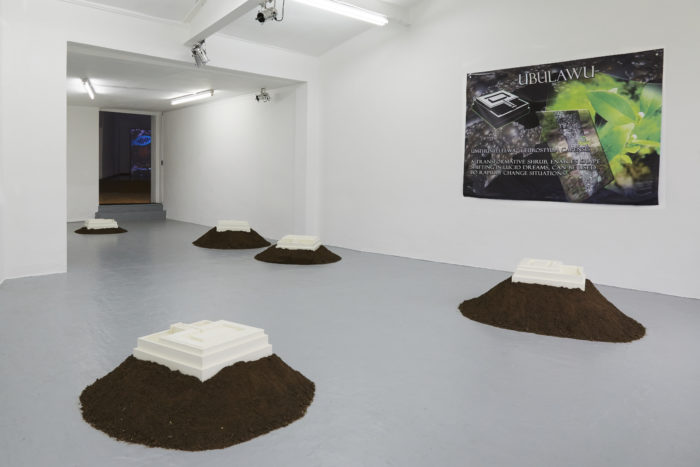
By the time I leave Auto Italia, something has happened. Weeks later, the connection still hasn’t dropped. I sit down and write this article. Whatever they put in the water, into that space, is still in my system.**
NTU presented Ubulawu at London’s Auto Italia running April 29 to June 11, 2017.
